Hello steemians!!!
Have you been wondering how your refrigerator works? Here is a simple but comprehensive article that explains the working principle of the refrigerator.
This post is basically about the Refrigeration Cycle and the major application, hence illustrating the processes involved in the refrigeration cycle, it may seems very difficult to comprehend but the post would be in its simpliest state.

Refrigeration is the process by which the temperature of a substance or space is reduced and this low temperature is maintained, by transferring heat from the substance or space. The device to do this function is called a Refrigeration Cycle,or simply a Refrigerator.
Before the advent of mechanical refrigeration water was kept cool by storing it in semiporous jugs so that the water could seep through and evaporate. The evaporation carried away heat and cooled the water. This system was used by the Egyptians and by Indians in the Southwest. Natural ice from lakes and rivers was often cut during winter and stored in caves, strawlined pits, and later in sawdust-insulated buildings to be used as required. The Romans carried pack trains of snow from Alps to Rome for cooling the Emperor’s drinks. Though these methods of cooling all make use of natural phenomena, they were used to maintain a lower temperature in a space or product and may properly be called refrigeration. The refrigeration system works on the principles of the reversed Carnot cycle in which heat is absorbed from a low temperature source and rejected to a high temperature sink, by supplying work to the system.
The Carnot cycle consists of two reversible Isothermal processes. Since the Carnot cycle is reversible, all four process comprising the Carnot cycle can be reversed.
If a machine working on reversed Carnot cycle is driven from an external source, it will work or function as a refrigerator. The production of such a machine has not been possible practically because the adiabatic portion of the stroke would need a high speed while during isothermal portion of stroke a very low speed will be necessary. This variation of speed during the stroke, however is not practicable. p-V and T-s diagrams of reversed Carnot cycle are shown in the figure below. The clearance space of the cylinder is full of air, the air is then expanded adiabatically to point p during which its temperature falls from T1 to T2, the cylinder is put in contact with a cold body at temperature T2. The air is then expanded isothermally to the point n, as a result of which heat is extracted from the cold body at temperature T2. Now the cold body is removed ; from n to m air undergoes adiabatic compression with the assistance of some external power and temperature rises to T1. A hot body at temperature T1 is put in contact with the cylinder. Finally the air is compressed isothermally during which process heat is rejected to the hot body.
The changes in the thermodynamic properties of the refrigerant throughout the cycle are indicated on the T-S diagram as shown above.
The cycle events are as follows;

1-2 (EVAPORATOR): At the lower pressure and temperature,the refrigerant enters the evaporator where the heat necessary for the evaporation is supplied from the heat source.
2-3 (COMPRESSOR): Wet vapour at state 1 enters the compressor and is compressed isentropically to state 2. The work input is W12.
3-4 (CONDENSER): Heat rejection in the condenser at constant pressure. It is completely liquid at this state.
4-1 (PUMP): Isentropic expansion behind the piston of an engine.
In simple, refrigeration means the cooling of or removal of heat from a system. The equipment employed to maintain the system at a low temperature is termed as refrigerating system and the system which is kept at lower temperature is called refrigerated system. Refrigeration is generally produced in one of the following three ways;
(i)By melting of a solid
(ii)By sublimation of a solid
(iii)By evaporation of a liquid.
Most of the commercial refrigeration is produced by the evaporation of a liquid called refrigerant. Mechanical refrigeration depends upon the evaporation of liquid refrigerant and its circuit includes the equipments naming evaporator, compressor, condenser and expansion valve. It is used for preservation of food, manufacture of ice, solid carbon dioxide and control of air temperature and humidity in the air-conditioning system.
Heat naturally flows in the direction of decreasing temperature I.e from high temperature regions to low temperature regions. These heat transfer occurs without requiring any device. However, the reversed process cannot occur by itself.
The heat transfer process from a low temperature region to a higher temperature one requires special device called refrigerators.

The figure above shows the operation of a refrigeration cycle. It works on the principle of a reversed Carnot cycle. The effect of the reversed Carnot cycle is to transfer a quantity of heat Q1 from a cold source at T1.
Q1 is the magnitude of heat removed from the refrigerated space at T1,while Q2 is the heat rejected to the workspace at T2,and W is the network input to the refrigerator.
Another device which transfers heat from a low temperature medium to a high temperature one is the heat pump. Refrigerators and heat pumps are essentially thesame device, they defer only in their objectives.
The objective of the refrigerator is to maintain a refrigerated space at low temperature, by removing heat from it. While for heat pump, the objective is to maintain a heated space at high temperature.
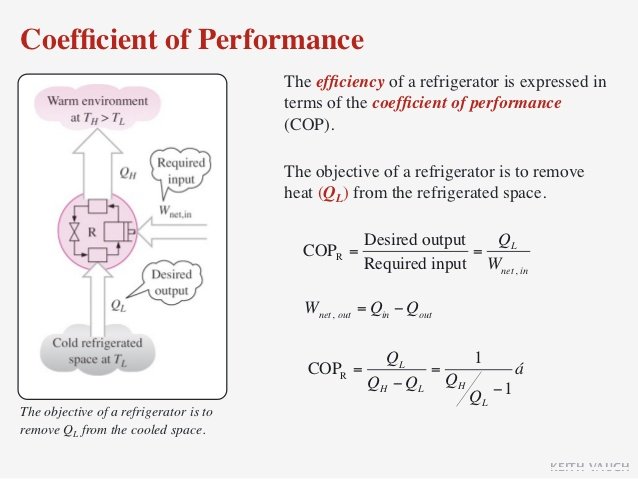
The C.O.P is an index of effectiveness of the system. It is defined as the ratio of the cooling effect produced to the energy supplied to the system. The performance of a refrigeration system is expressed by a term known as the ‘‘co-efficient of performance’’, which is defined as the ratio of heat absorbed by the refrigerant while passing through the evaporator to the work input required to compress the refrigerant in the compressor ; in short it is the ratio between heat extracted and work done (in heat units).
- Network input=W41-W23
- Net heat supplied £Q=Q3-Q2
C.O.Pref=Q1/Q2-Q1
And;
C.O.Php=Q2/Q2-Q1.
Important refrigeration applications;
- Medical and surgical aids
- Transportation of foods above and below freezing
- Industrial air-conditioning
- Freezing food products
- Comfort air-conditioning
- Ice making
- Chemical and related industries
- Processing food products and beverages
- Oil refining and synthetic rubber manufacturing
- Manufacturing and treatment of metals
- Miscellaneous applications : (i) Extremely low temperatures (ii) Plumbing (iii) Building construction etc.
The most widely used refrigerators and heat pumps are those which use a liquifiable vapour as the refrigerant. The refrigerant is vapourised and condensed alternately and is compressed in the vapour phase.
Functions of Parts of a Simple Vapour Compression System Here follows the brief description of various parts of a simple vapour compression system.
- Compressor:
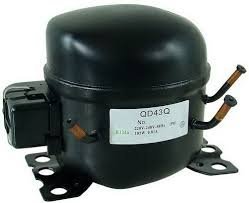
image credit
The function of a compressor is to remove the vapour from the evaporator, and to raise its temperature and pressure to a point such that it (vapour) can be condensed with available condensing media. - Discharge line (or hot gas line):
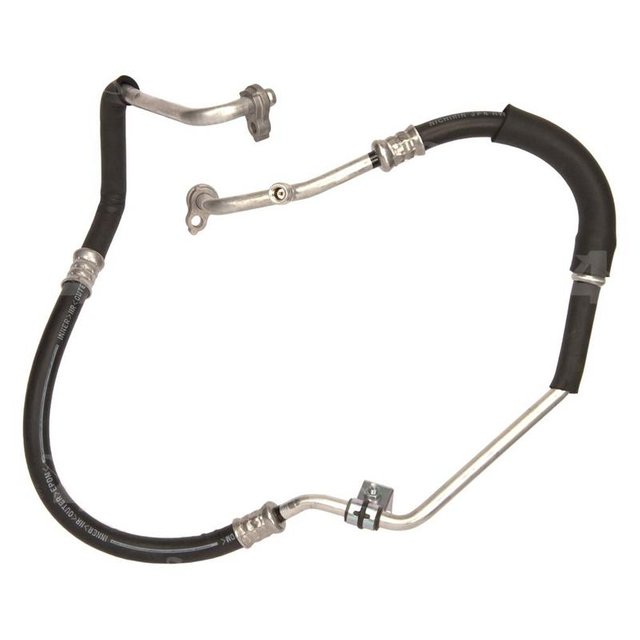
image credit
A hot gas or discharge line delivers the high-pressure, high-temperature vapour from the discharge of the compressor to the condenser. - Condenser:
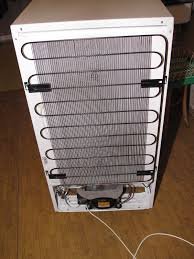
image credit
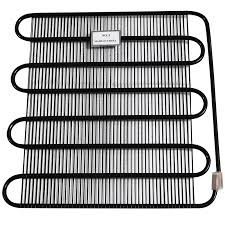
image credit
The function of a condenser is to provide a heat transfer surface through which heat passes from the hot refrigerant vapour to the condensing medium. - Receiver tank:
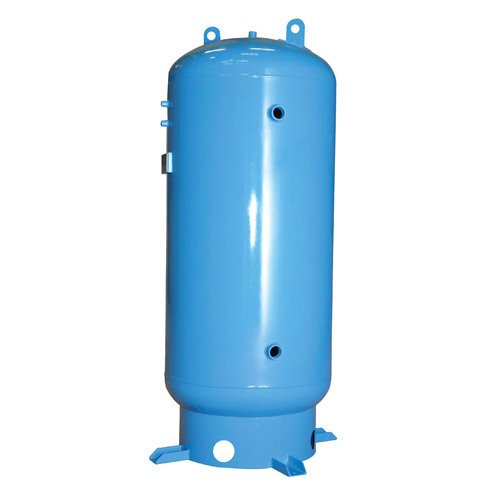
image credit
A receiver tank is used to provide storage for a condensed liquid so that a constant supply of liquid is available to the evaporator as required. - Liquid line:
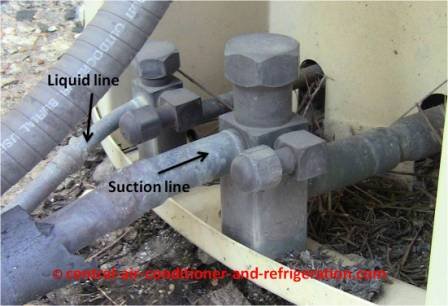
image credit
A liquid line carries the liquid refrigerant from the receiver tank to the refrigerant flow control. - Expansion valve (refrigerant flow control):
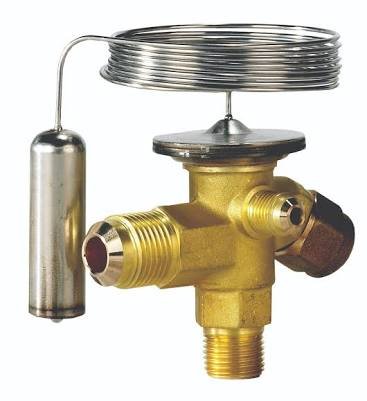
image credit
Its function is to meter the proper amount of refrigerant to the evaporator and to reduce the pressure of liquid entering the evaporator so that liquid will vapourize in the evaporator at the desired low temperature and take out sufficient amount of heat. - Evaporator:
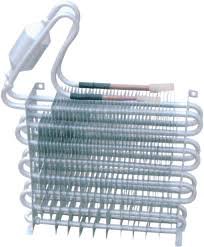
image credit
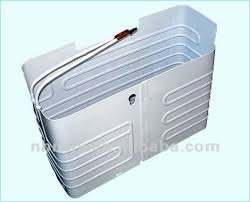
image credit
An evaporator provides a heat transfer surface through which heat can pass from the refrigerated space into the vapourizing refrigerant. - Suction line:

image credit
The suction line conveys the low pressure vapour from the evaporator to the suction inlet of the compressor.
Due to impraticalities, several modifications have been done to the ideal cycle using vapour as the working fluid:
- Replacement of the expansion engine by a Throttle valve
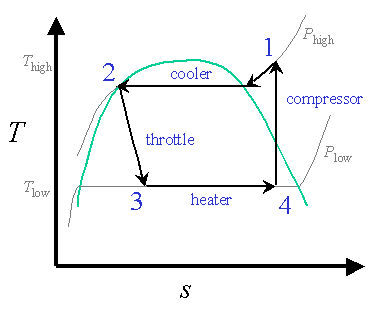
The refrigerator plant is simplied by replacing the expansion cylinder with a throttle device such as expansion valve or cappilary tube. Throttle is a constant process and the process is highly irreversible. Thus making the process irreversible.
- Condition of the refrigerant at the compressor inlet

To make complete use of the specific enthalpy of the vaporization of the refrigerant of the evaporator. It is desirable to continue the process until the vapour us dry saturated. In a practical unit, this process is extended to give the vapour a definite amount of superheat.
It is a practical neccessity to allow the refrigerant to become upper heated so as to prevent carry over of liquid refrigerant into the compressor.
- Under-Cooling of the condensed vapour
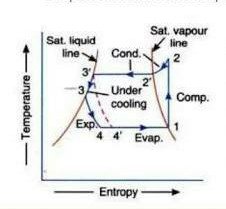
The condensed vapour can be cooled at constant pressure to a temperature below that of the saturation temperature corresponding to the condenser pressure.
Subcooling in the condenser increases the refrigerating effect and thus the coefficient of performance of the process. Subcooling can be done by;
- Circulating a greater quantity of water through the condenser
- Using water, cooler than the main circulating water
- Inserting a special coil between the condenser and the expansion valve.
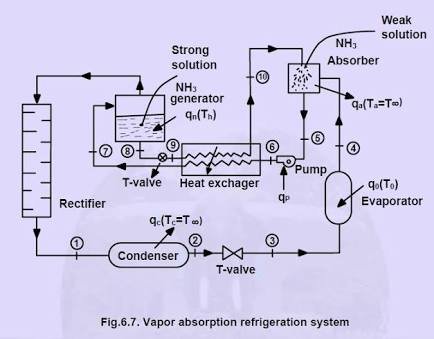
A ‘refrigerant’ is defined as any substance that absorbs heat through expansion orvaporisation and loses it through condensation in a refrigeration system.
The term ‘refrigerant’in the broadest sense is also applied to such secondary cooling mediums as cold water or brine,solutions. Usually refrigerants include only those working mediums which pass through the cycleof evaporation, recovery, compression, condensation and liquification. These substances absorb heat at one place at low temperature level and reject the same at some other place having highertemperature and pressure. The rejection of heat takes place at the cost of some mechanical work.Thus circulating cold mediums and cooling mediums (such as ice and solid carbondioxide) are not primary refrigerants. In the early days only four refrigerants, Air, ammonia (NH3), Carbon diox-ide (CO2), Sulphur dioxide (SO2), possessing chemical, physical and thermodynamic propertiespermitting their efficient application and service in the practical design of refrigeration equipmentwere used. All the refrigerants change from liquid state to vapour state during the process. Classification of Refrigerants.
The refrigerants are classified as follows:
Primary refrigerants: Primary refrigerants are those working mediums or heat carriers which directly takepart in the refrigeration system and cool the substance by the absorption of latent heat e.g.Ammonia, Carbon dioxide, Sulphur dioxide, Methyl chloride, Methylene chloride, Ethyl chlorideand Freon group etc.
Secondary refrigerants: are those circulating substances which are first cooled withthe help of the primary refrigerants and are then employed for cooling purposes, e.g. ice, solidcarbon dioxide etc. These refrigerants cool substances by absorption of their sensible heat.The primary refrigerants are grouped as follows :
(i) Halocarbon compounds: In this group are included refrigerants whichcontain one or more of three halogens, chlorine and bromine and they are sold in the market underthe names as Freon, Genetron, Isotron, and Areton.
(ii) Azeotropes: The refrigerants belonging to this group consists of mixtures of different substances. These substances cannot be separated into components by distillations. They possess fixed thermodynamic properties and do not undergo any separation with changes in temperature and pressure.
(iii) Hydrocarbons: Most of the refrigerants of this group are organic compounds. Several hydrocarbons are used successfully in commercial and industrial installations. Most of them possess satisfactory thermodynamic properties but are highly inflammable.
(iv) Inorganic compounds: Before the introduction of hydrocarbon group these refrigerants were most commonly used for all purposes.
(v) Unsaturated organic compound: The refrigerants belonging to this group possess ethylene or propylene as their constituents.
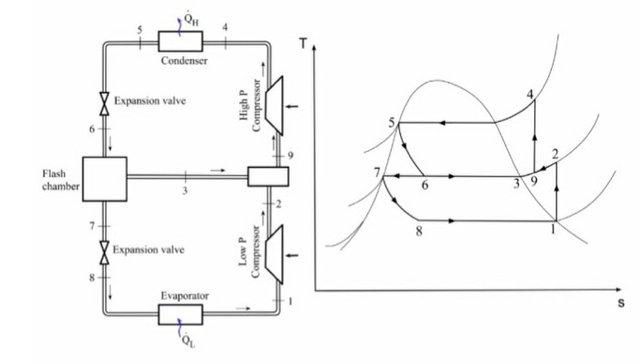
The performance of a vapour compression system that uses an ejector as an expansion device was investigated. In the analysis, a two‐phase constant area ejector flow model was used. R134a was selected as the refrigerant. According to the obtained results, for any operating temperature there are different optimum values of pressure drop in the suction chamber, ejector area ratio, ejector outlet pressure and cooling coefficient of performance (COP). As the difference between condenser and evaporator temperatures increases, the improvement ratio in COP rises whereas ejector area ratio drops. The minimum COP improvement ratio in the investigated field was 10.1%, while its maximum was 22.34%. Even in the case of an off‐design operation, the performance of a system with ejector is higher than that of the basic system.
This cycle can be improved by;
- The introduction of a flash chamber
- Using an accumulator or a cooler
- Sub-cooling the liquid refrigerant
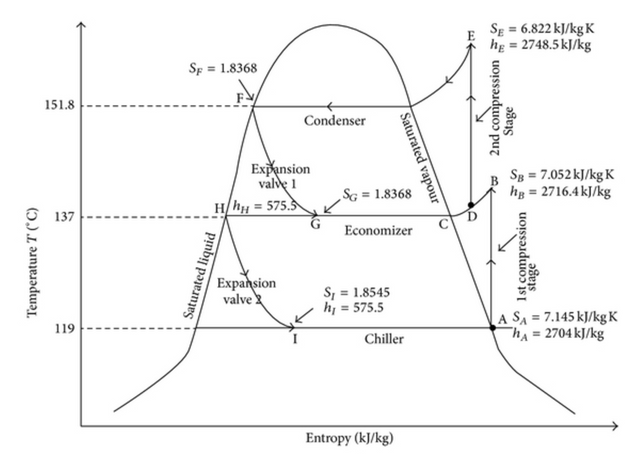
In commerce and manufacturing, there are many uses for refrigeration. Refrigeration is used to liquify gases - oxygen, nitrogen, propane and methane.The measured capacity of refrigeration is always dimensioned in units of power. Domestic and commercial refrigerators may be rated in kJ/s, or Btu/h of cooling.
Also, do not forget that if you want to ensure that the refrigeration cycle works smoothly, it is necessary to carry out timely maintenance of freezers. Here you can find out more about such services from fourelementservice https://fourelementservice.com/walk-in-cooler-freezer/ . Freezers are an indispensable equipment for high-quality and long-term storage of various food preparations.
Downvoting a post can decrease pending rewards and make it less visible. Common reasons:
Submit